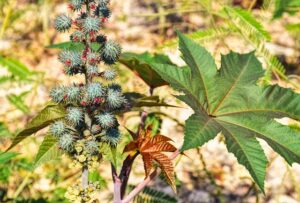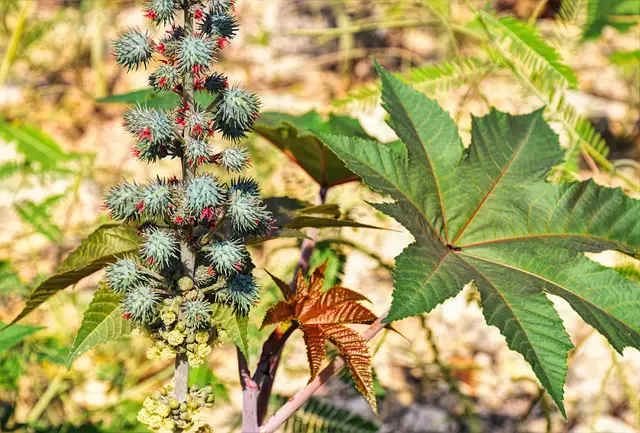Castor beans, though not members of the true beans family as implied by their colloquial name, are the reason why we have castor oil — an ancient time ingredient having tremendous medicinal, pharmaceutical and industrial applications.
Castor oil for example, is an FDA approved food additive, which means it can safely be used in food articles for its medicinal properties to be reaped.
It is commonly used as a release agent in making hard candies and also as a key ingredient in oral tablets.
Castor oil is also beneficial in manufacturing soaps, paints, vanishes, motor oils, inks and solid lubricants. And these are only a few of the vast applications of castor oil in our lives.
Now don’t get it wrong, because the beans of the castor plant are the sole reason why castor oil exists — a popular by-product we’re already conversant with it’s tremendous medicinal and industrial applications, doesn’t necessarily mean the former is perfectly fine to consume too. As a matter of fact, the opposite is true.
Castor beans are completely inedible and should be avoided at all cost. The poisonous constituent is ricin which is a naturally occurring toxin that is extremely poisonous. So poisonous that in fact a few seeds of the beans can prove very fatal for individuals who ingest them.
So consuming castor beans, the plant as well as the flowers is a very big no. Only consume processed castor bean products such as the castor oil which have the ricin already separated from its composition by virtue of its insolubility in oil.
Read: Can You Eat Lamb Rare?
Below, we talk more on the potency of castor beans, the plants and also the flowers and how castor oils are extracted “toxin free” from the beans.
As a matter of interest, we also talked about how wild animals cope with consuming castor beans in the wild.
The toxin in castor beans is 12,000 more potent than rattlesnake venom
Yes, you read that correctly! The ricin in castor beans, those ½ inch long seeds mottled with patterns reminiscent of those on the gorgeous african rock python, are more dangerous than the venom of a rattlesnake!
Just to put things in perspective, rattlesnake bites are almost always an emergency case even though it’s rarely fatal, which means that if left untreated, the afflicted individual will most likely end up dying in a fee days time.
Read: Can You Eat Cashew Fruit?
So now imagine something 12,000 times more potent than such venom! Simply unimaginable right? But the seeds of the castor plant contain a compound that can easily manage that height!
It’s called Ricin. Ricin is a naturally occurring toxin that is extremely potent. Yes, it’s the same compound the US military considered using as chemical warfare in the 20th century. For that purpose, ricin was to be made into a partially purified substance and exposed to people through air, food or drinks which would end up causing serious side effects and eventually death.
Castor seeds when consumed by chewing will release the ricin compound in the body which will begin its effects after some few hours, and in some cases, some few days.
Read: Can You Eat Raw Plantain?
And this all depend on the amount of seeds consumed which directly affects how much of the ricin ends up being deactivated in the stomach — because some of it actually ends up being deactivated in the stomach!
The side effects and complications from chewing and ingesting castor seeds include vomiting, nausea, very rapid heart rate, and seizures that persist for several days, according to the Handbook of Pesticide Toxicology.
But these symptoms can be managed pretty easily and well when the case is reported earlier and proper treatment is administered.
When castor seed is swallowed instead of chewed however, the side effect is rarely ever fatal.
Read: Can You Eat Turmeric Raw?
Thus, the reason why some people have reported ingesting few castor seeds without any side effects.
And when you’re fully vaccinated against ricin, you’d have really no problem consuming castor seeds as you’ll be perfectly fine to begin with. But still yet, avoid it at all cost!
Castor seeds isn’t only poisonous when ingested, but also when applied to the skin, and inhaled through air, so avoid crushing seeds with hands and then breathing the air around the area.
Can you eat castor plant leaves and flowers?
Just like the seeds, the glorious leaves that surround the castor seeds are also poisonous too.
 They contain many toxic principles including ricin which can prove fatal to the person consuming them.
They contain many toxic principles including ricin which can prove fatal to the person consuming them.
Read: Can You Eat Broccoli Leaves?
The negative side effects of consuming the castor plants and leaves include salivation, ataxia and muscle tremors.
Does it affect pets and livestocks too?
Bird pets are especially poisoned from eating castor seeds because the seeds are grounded in their very muscular stomach (gizzard) to release the ricin for intestinal absorption, which then makes the toxin available to the body for circulation.
Aside birds. Other pets and livestocks too like dogs, sheeps, cats, horses and cattle can get poisoned from consuming castor plants and seeds.
Pets may develop symptoms of poisoning such as loss of appetite, weakness and trembling while cattle may develop bloating of the rumen and get frequent indigestion as a result of alterations in their intraruminal system.
Despite proving fatal to humans, pets and livestocks, poisoning to wild animals have rarely ever been documented, and it might be due to some sort of adaptation that allows animals that partly subsist on the leaves to deactivate the ricins in their stomach (much like it happens in our stomach to some extent) and absorb the beneficial compounds present in the leaves.
How is castor oil extracted without the toxin then?
One physical property of ricin is the sole reason why extracting oil by crushing castor beans is very easy and safe. Ricin is insoluble in oil.
This means that whenever oil is pressed out of castor beans, the ricin is not soluble in it, or does not dissolve in it, or isn’t carried along with it, and thus, an automatic removal is already achieved.
Despite the insolubility of ricin in oil, very little amount of it still find its way into the castor oil, and the way manufacturers get rid of this without compromising the quality of oil and also it’s safety, is to heat the oil below it’s smoke point (200 °C) but higher than what the ricin compound can stand. And the sweet spot happens to be 80 °C (or 176 °F).
The application of the heat causes the protein living in the cells to lose their quaternary structure present in their native state, and this invariable causes the cell to perish, thus eliminating any leftover trace of ricin in the castor oil.
After pressing out oil from the beans, the remaining element is the cake which definitely has a good concentration of ricin still capable of causing livestocks to perish.
While this cake is highly beneficial to use as feed for livestock, the ricin must first be removed via autoclaving first, otherwise, the result can prove fatal.
Final thoughts
Castor beans are not safe to consume, especially by chewing as they contain ricin which is a naturally occurring toxin. Ricin is estimated to be 12,000 times more potent than the venom of the rattlesnake which by itself is already extremely dangerous.
While the castor beans are not edible, the oil pressed out from it using careful manufacturing techniques and machinery is perfectly safe to consume and has a wide array of medicinal and industrial applications.
The leftover cake however, cannot be consumed and should also not be given to livestocks to eat because it contains a good amount of ricin which can be harmful to them, unless the ricin is removed through the process called autoclaving.

